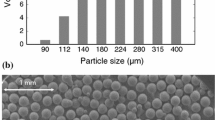Summary
The flow properties of a highly filled polyisobutylene polymer have been investigated. The solid filler is mainly an inorganic crystalline material with a multimodal size distribution in the range of 10–750µm. The loaded polymer has properties which are viscoelastically non-linear and which depend on the testing environment.
Apparatus developed at the RPE enables a differential gas pressure to be applied across the faces of a plug of material encased in a rigid brass tube. The resulting stresses are mainly those of telescopic shear. Samples are tested under controlled conditions and the deformations recorded by successive photographs taken at known times. The deformations at various points on the profile were measured from these photographs.
Two sets of identical samples were tested at the same differential pressure and temperature. The first set was deformed under a hydrostatic gas pressure of 0.10 MN/m2 (atmospheric pressure), and the others with a hydrostatic gas pressure of 7.0 MN/m2 (1000 psig). The results show that an increasing hydrostatic gas pressure reduces substantially the ability of the material to deform when stressed in shear. The significance of and a possible mechanism for this reduction in deformability is briefly discussed.
Similar content being viewed by others
Abbreviations
- b :
-
outer radius of sample (25 mm)
- l :
-
length of sample (50 mm)
- P 1 :
-
applied high pressure
- P 2 :
-
applied hydrostatic pressure
- (P 1 –P 2):
-
deforming pressure
- τ :
-
shear stress
- τ max :
-
maximum shear stress at outer radius of sample
References
Buswell, H. J., Rheol. Acta9, 577–584 (1970).
Gledhill, V. M. andW. A. Dukes, ERDE Tech. Report 87 (1972).
Vernon, J. H. C., ERDE Tech. Memo. 13/M/62 (1962).
Buswell, H. J., RPE Tech. Report 70/2 (1970).
Buswell, H. J. andJ. F. Moloney, RPE Tech. Report 68/6 (1968).
Buswell, H. J., J. F. Moloney, andG. S. Pearson, Rheol. Acta8, 2, 240 (1969).
Buswell, H. J., RPE Tech. Memo. 575 (1971).
Yule, G. andM. G. Kendall, Introduction to the theory of Statistics (London 1958).
Church, G. J., D. E. England, andJ. H. C. Vernon, ERDE Tech. Report 3/R/62 (1962).
Dukes, W. A., Proc. 5th Int. Congress on Rheology. Ed.S. Onogi. Vol. 2 (Univ. of Tokyo Press 1970).
Author information
Authors and Affiliations
Additional information
With 8 figures and 2 tables
Rights and permissions
About this article
Cite this article
Buswell, H.J. The effect of pressure on the flow properties of filled polyisobutylene. Rheol Acta 13, 571–576 (1974). https://doi.org/10.1007/BF01521758
Received:
Issue Date:
DOI: https://doi.org/10.1007/BF01521758




